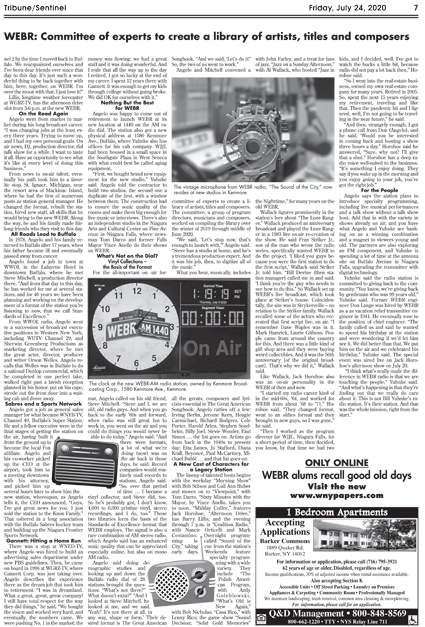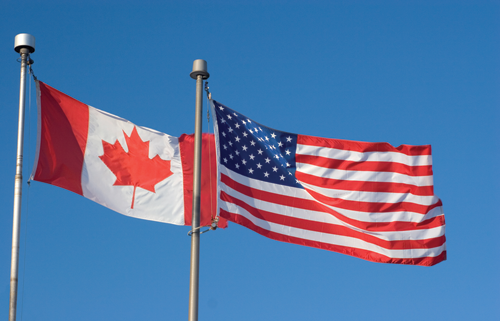Featured News - Current News - Archived News - News Categories
By Karen Carr Keefe
Radio station WEBR is making a comeback to its hometown of Buffalo, at 1440 on the AM dial. After a 27-year absence, this historic “Buffalo Born” radio station looks to have a strong reemergence on local airwaves, which will be music to the ears of Western New Yorkers who could not find any trace of the classic standards from the “Great American Song Book” anywhere on the AM or FM dial.
The station is headed by Buffalo natives Bill Yuhnke and Don Angelo.
Karen Carr Keefe recently chatted with some WEBR alums.
Click HERE to read her full article.
Alumni of the former WEBR have fond memories of their time at Newsradio 970 in the 1970s and ’80s and are cheering on the new version of WEBR that hit the airwaves earlier this month. Pete Weber has a continuing connection with the new WEBR; Teresa Beaton Corrigan has the distinction of having worked in news at both WEBR and WJJL; and Budd Bailey has a brick from the now-demolished longtime home of “The Sound of the City,” 23 North St., Buffalo.
Pete Weber, sportscaster
Pete Weber, an award-winning play-by-play announcer for the NHL’s Nashville Predators since 1998, initially worked at WEBR in the ’70s as a sportscaster, then as sports director.
He said the early years at WEBR were a very solid basis for his subsequent career. “Well, ’76 to ’78 was really my first opportunity to work in a major radio market,” Weber said. He started in radio in South Bend, Indiana.
Hearing that veteran Buffalo broadcasters Don Angelo and Bill Yuhnke have revived WEBR was good news to Weber.
“The whole idea of those call letters being back on the air!” That was happy news for him, unlike in 1993, when Western New York Public Broadcasting retired the WEBR call letters. “That hit me like a punch in the gut,” he said. “Those call letters put me on my way to what I think has been a pretty happy career – which is not over yet. And who would’ve imagined that?”
The early years at WEBR amounted to hard but rewarding work for Weber. “The good part was that I wasn’t making any money, but I also didn’t have any time to spend it.”
With radio stalwarts such as Sam Anson, Jim Militello, Budd Bailey and John Hagar, the schedule was rigorous. “We covered everything!” Weber said. “I’d say between Sam and myself, we probably combined for about 60 college basketball play-by-play games, 10 to 12 UB hockey games, and then we did Canisius College football. So that was really catch-it-as-you-can, polish your craft, without having to think about the polishing. Just do it!”
Weber went on to be a color commentator for the Los Angeles Kings hockey team. Returning to Buffalo in 1982, he worked for the Buffalo Bills, did radio play-by-play for the Sabres and spent 13 seasons with the Buffalo Bisons.
“ I remember, I was telling people in South Bend that I was moving to Buffalo. And they go, ‘Buffalo! What a horrible place! You can’t go there.’ He disagreed. “I’m going, ‘No, no, no, no. I’m sorry,’ ” he told them. “In fact, one of the reasons I applied to the ad in Broadcasting Magazine, my godfather worked for International Chimney. He was my dad’s Army buddy during World War II, and they had welcomed me to come (to Buffalo) if things should work out. And they did, obviously, and what a wonderful launch that was for me!”
Weber noted with a laugh the similarity of his last name and the call letters of the station. “You wouldn’t believe how many people thought that I was some kid from Black Rock … who had changed his name to conform to the radio station’s call letters. I said ‘No, my name really is Weber. It’s nothing along those lines. It’s just a great coincidence.’ ”
Weber has high hopes for the new WEBR. “I think it’s great. I want to see what kind of inroads they can make.” He will be helping the new station, voicing some on-air messaging. And he has something special in store for Angelo. “I’m going to surprise him with some old archival stuff that I have.”
He has sports reports from back in the day, including a post-game interview with a still-disbelieving coach Jerry West after a comeback win for the Buffalo Braves basketball team over the Lakers.
Teresa Beaton Corrigan, reporter, anchor, teacher
Teresa Beaton Corrigan, reporter and anchor for the old WEBR, had the unique experience of working at both WJJL, and WEBR, which now has WJJL’s position at 1440 on the AM dial.
“ I loved my time at WJJL! I was 20 years old, soaking wet behind the ears, and so excited about everything!” she said. “Everyone was so very kind to me, from the owner, to my boss, the sales department, the DJs … everyone! I loved banging out stories on the typewriter, checking the clanking UPI machine, and calling the police and fire departments every morning as part of my rounds.”
She worked with WJJL’s longtime newsman, Tom Darro, who has handled breaking news and community goings-on for decades at the radio station. He is a staple of the talent lineup at the new WEBR, as well, hosting “View Point” from 9:05 to 11 a.m. weekdays.
Corrigan has fond memories of Falls radio news. “I especially loved doing the news during Yankee games, hanging out with the DJ, Chuck Mandrell, learning about baseball, then running into the studio to read the news when there was a break. I liked Chuck so much I asked him to DJ at my wedding,” she recalled.
“At WJJL we would ‘string’ for WEBR, so after college I ended up there, and my education continued. I had so much to learn, and so many great teachers. I feel very lucky.” Corrigan said the old WEBR was a great place to be. She worked there from 1980-92 and fell in love with radio because of the immediacy.
“You just felt the vibe in the air of everyone working so hard and trying to do their best,” she said of the young and energetic radio staff at the time.
She compared the camaraderie and hard work to the contemporaneous show “Fame” that was on TV and film. “It was that same feeling,” she said. “Just like striving and being young and working together.”
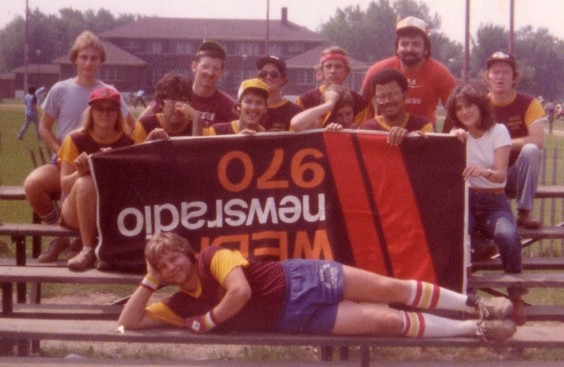
The WEBR softball team, circa 1978. The team was named the Revolving Doors because of the frequent staff turnover. Some team members seen in the photo: In front, Paul Hamilton; middle row, from left: Maureen Rasp-Glose, Budd Bailey, Brad Krohn, unidentified staffer, Greg Mott, Dawn Hamilton; back row, Scott Brown, Leon Thomas Lewek, Sally Lewek, unidentified reporter, Dennis Keefe and Sam Anson. (Photo courtesy Budd Bailey)
The Love Canal environmental disaster was a standout news story during her tenure at WEBR. She recalled volunteering long hours on team coverage of the Love Canal disaster declaration. Station management had said “no overtime” was available for staff coverage of the event, but few complained.
“I was like, That’s OK,’ and several other people said, ‘That’s OK, we don’t need any overtime, we just need to do more of this work,’ ” Corrigan said. “And you wish they had beds there. You just wanted to live it, the whole time.”
The work itself was the motivation, she said. “It was just a great experience to be with everyone and to learn from people and to be excited and to want to give people information to give them power.”
WEBR’s news heyday began before the internet, and people relied on the all-news format for knowledge, to form opinions and to take action, Corrigan said. She remembers news directors and editors stressing that “we’re an issue-oriented radio station … we’re going to look at things over long-term.”
Corrigan reported on environmental issues, education and politics. Looking back, she said she took seriously the mission to inform people. “We’re not just looking for the flashy stuff, we’re being here because you can’t. And we’re being here to help you learn how to get your voice heard.”
Corrigan went on to a long career in teaching elementary school, including 20 years in the primary grades at Forrest Elementary in Williamsville. She now teaches yoga and is set to begin as an instructor for undergraduate future teachers at SUNY Buffalo State in the fall, COVID-19 guidelines permitting.
Budd Bailey, sportscaster, reporter, editor
Budd Bailey began as an intern, then part-time sportscaster at WEBR in 1978, just about the same time Weber was leaving the station. Eventually Bailey, a graduate of Syracuse University’s journalism school, did a combination of sports and news to make up a 40-hour week. Bailey ended up staying at WEBR until 1986 and returned for a short while in 1993. In 1986, he began a stint with the Buffalo Sabres, where he was director of information in the public relations department. He joined the Buffalo News in 1993, where he was a sports reporter and copy editor. Since retiring in 2017, he has been a columnist for BuffaloSportsPage.com and is the author of 11 books.
He is the perfect person to bring together alumni from the sports and news side of the WEBR alumni team, which is exactly what he did in two reunion meetings on Zoom this spring, during the height of the pandemic.
“I really didn’t anticipate the amount of joy and emotion that came through in those Zoom meetings. Everybody just seemed thrilled to look at each other and talk and laugh together again, and it was really better than I expected,” he said. “There’s a lot of people from WEBR that are on Facebook, and it was just a matter of linking them together. I almost got the sense that people really didn’t want to hang up after a while. They stayed as long as possible. I think one of them (the Zoom calls) lasted almost two hours.”
Bailey is also an ideal person to compare the old with the new WEBR. “I turned it on today and they were playing something in the Great American Songbook, Barry Manilow or something, and the WEBR I knew, obviously, wouldn’t have done that, but the WEBR that our parents might have listened to back in the day, before it went all news in 1976, probably would have felt right at home; so in that sense, it’s kind of nice.”
The return of the call letters intrigues him. “I think it’s an odd sensation, because the call letters have been out of town for at least 20 years … but to pop up again is kind of interesting. It’s almost like when WECK came back and hired Danny Neaverth and all sorts of other DJs,” Bailey said. “Now they’re back on the air, and it’s nice to hear them again doing so well.”
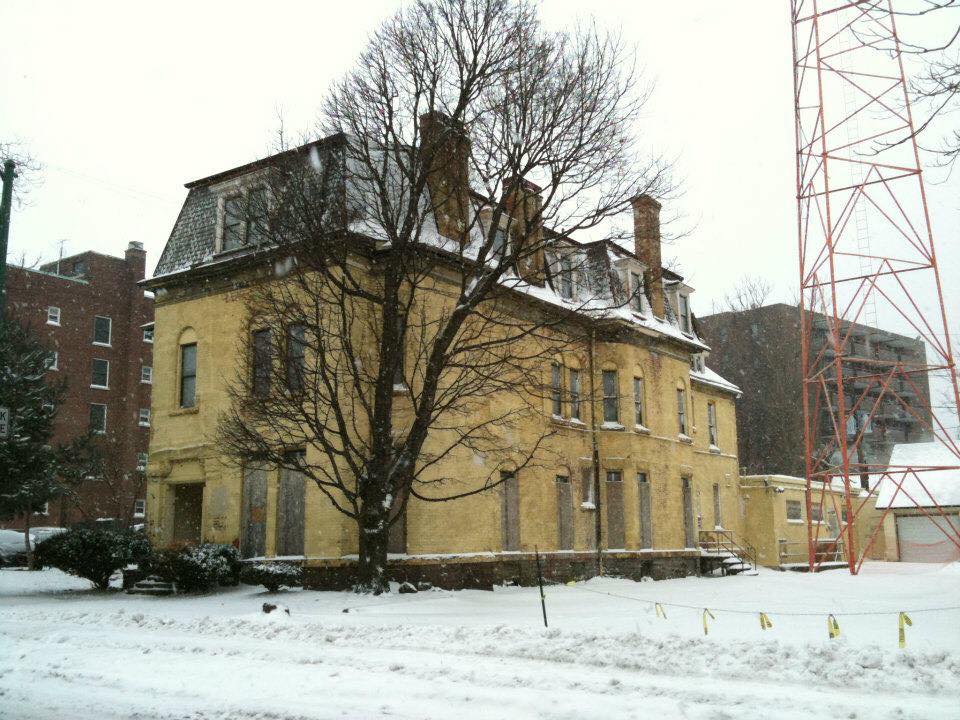
The WEBR building at 23 North St., Buffalo. (Photo courtesy Budd Bailey)
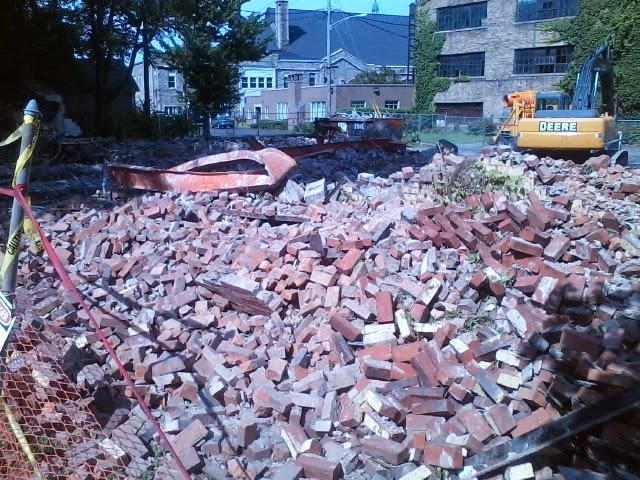
On July 8, 2014, the historic WEBR building, at 23 North St., was demolished by the City of Buffalo after the building was struck by lightning. (Photo courtesy Budd Bailey)
When Bailey recently heard WEBR’s classic, 1960s-era, “Sound of the City” anthem on the new WEBR, he recalled coming across a “cart” with the song during his Newsradio 970 days in the late ’70s. Before digital technology, radio sound was stored on carts made of analog tape that loops back to the beginning after it plays. “Someone had saved it in the transition in ’76 and said, ‘Well, let’s keep this as a little bit of history,’ ” Bailey said.
Another historic relic is a sad reminder of bygone days. “I do have a brick of the WEBR building,” Bailey said. On July 8, 2014, the historic building on North Street was demolished by the City of Buffalo after it was struck by lightning. “I took a brick from the building when they tore it down. And I gave another brick to Paul Hamilton.”
Hamilton also began his radio career at WEBR, spent more than 25 years on WGR 550-AM radio as that station’s Sabres reporter and recently joined WGRZ-TV to provide commentary and analysis on the Sabres and NHL.
What did Bailey like best about working at WEBR? “This is almost a cliché, but it was the people there, who were very energetic, very smart, very talented, and fun to be around,” he said.
“I remember in college, we had a very good group on our school newspaper that still sees each other quite a bit. And I think we were all a little afraid that we’d never have as good a journalism experience once we got out of college as we did there. And I went to WEBR, and that was a very similar atmosphere that people would joke around a little bit, go out to dinner and go to parties together. … So, it was a similar type of experience that we enjoyed, and after that, I was kind of thinking, ‘Well, is everything going to be like this?’ I had a couple other jobs from there, and, no, everything is not like this.”
Bailey said WEBR was quite a training ground for those who went on in journalism careers. “It was a very energetic crew, and if you look at the business model of having an all-news station that’s public – obviously it hasn’t been copied anywhere else ’cause it’s quite an effort – and after a while, I think we all thought that it might come to an end one way or another. And sure enough, that’s exactly what happened in ’93; but it lasted 17 years, so it was quite a noble experiment.”
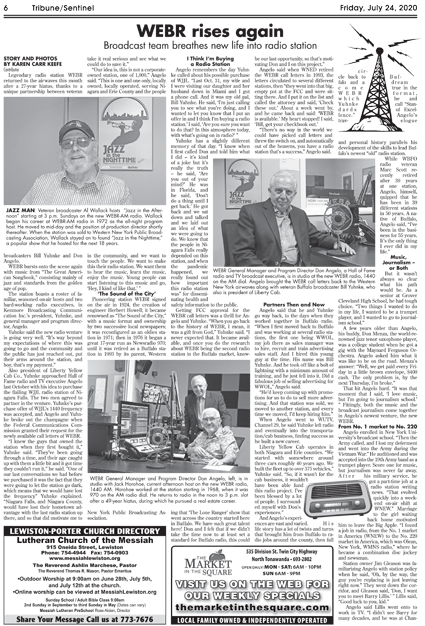
WEBR Feature Article Page 1: Click to enlarge
